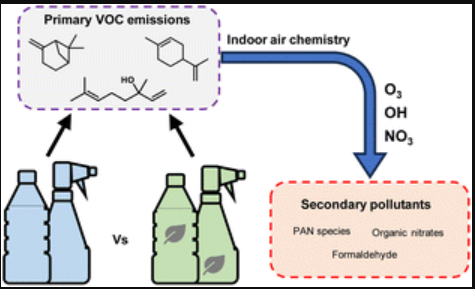Indoor air pollution from cooking and cleaning
Two recent research papers from York scientists have demonstrated the emission of indoor air pollution given off when cooking or cleaning indoors.

The research teams were led by Professor Nicola Carslaw in the Department of Environment and Geography (DEG) and Dr Terry Dillon from the Wolfson Atmospheric Chemistry Laboratories (WACL), Department of Chemistry. The research was funded by the EPSRC and is part of the IMPeCCABLE project.
In developed countries people spend approximately 90% of their time indoors, which means that the majority of the air we breathe contains pollutants derived from indoor activities. One important group of air pollutants are Volatile Organic Compounds (VOCs), which are emitted by a huge range of products, such as candles, air fresheners, building materials, soft furnishings and cleaning products, and by activities such as cooking and cleaning.
While many VOCs are harmless, some do impact on health. In addition, some VOCs react with other compounds found in indoor air, and can form secondary products that are more harmful. Domestic cooking and cleaning in homes are large sources of VOCs.
The WACL research team investigated the types of VOCs that are emitted from cooking a typical meal. A stir-fry was cooked multiple times whilst the air was sampled and the use of Selected-Ion Flow-Tube Mass Spectrometry (SIFT-MS) allowed for real-time VOC monitoring.
This same technique was used in the laboratory in combination with another high-resolution mass spectrometry technique to measure the VOCs that are directly emitted from a range of regular and green cleaning products. Results from both studies were used to simulate virtual cooking and cleaning experiments using computer models developed in the Department of Environment and Geography.
The first research paper published in Environmental Science: Processes & Impacts was led by Dr Helen Davies from the Department of Environment and Geography. It highlighted that frying with oils resulted in large amounts of harmful aldehydes being emitted, vegetables produced alcohols and that cooking spices yielded high concentrations of reactive monoterpenes (naturally occurring fragrance compounds).
In the second paper, also published in Environmental Science: Processes & Impacts, Ellen Harding-Smith reported that these reactive monoterpenes were found in both regular and “green” fragranced cleaning products. The “green” cleaning products were found to emit more monoterpenes compared to regular cleaners, while non-fragranced products (green and regular) emitted much less.
Subsequent investigation using computer models developed in the Department of Environment and Geography demonstrated that monoterpenes from cooking and cleaning were the main driver of formaldehyde production. Formaldehyde is a known carcinogen at high enough concentrations. The identity of the monoterpenes in the cleaning products was important as some monoterpenes are much more reactive than others, and so can produce larger quantities of the harmful secondary products. While green cleaners emitted more monoterpenes overall, it was the regular cleaning products that emitted the most reactive species and thus were responsible for more harmful secondary products.
Dr Helen Davies explained, “models also allowed us to investigate which environmental factors had the most influence on the indoor air chemistry. We found that cooking/cleaning in a house with a more polluted outdoor environment enhanced the formation of harmful secondaries indoors, as more reactive ozone entered the building from outside. This has implications when considering future climate change, as warmer conditions and more polluted outdoor air may further decrease the quality of the air we breathe indoors.”